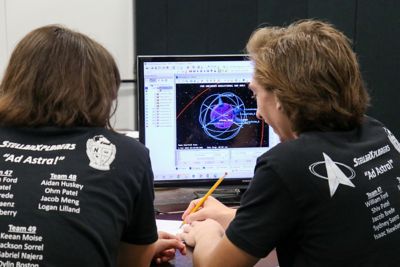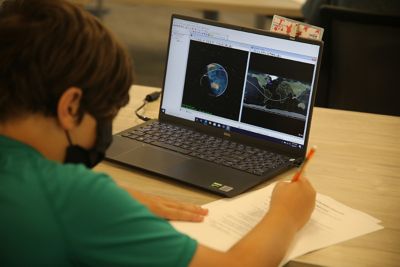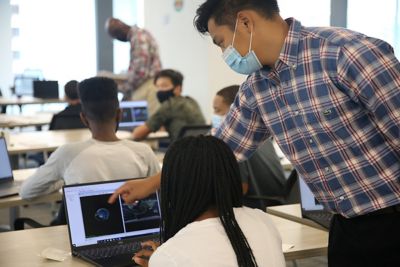-
-
Access Free Student Software
Ansys empowers the next generation of engineers
Students get free access to world-class simulation software.
-
Connect with Ansys Now!
Design your future
Connect with Ansys to explore how simulation can power your next breakthrough.
Countries & Regions
Free Trials
Products & Services
Learn
About
Back
Products & Services
Back
Learn
Ansys empowers the next generation of engineers
Students get free access to world-class simulation software.
Back
About
Design your future
Connect with Ansys to explore how simulation can power your next breakthrough.
Free Trials
ANSYS BLOG
January 9, 2023
Preparing for Takeoff: Students Use Digital Mission Engineering to Launch Careers in STEM
Middle school and high school students from around the world who are interested in science, technology, engineering, and mathematics (STEM) fields are getting hands-on experience with real-world engineering challenges through the StellarXplorers Space STEM Program.
The program, which launched in 2014, was created at the request of the U.S. Air Force by the Air & Space Forces Association (AFA), an independent professional military association for the U.S. Air Force and U.S. Space Force.
Since its inception, StellarXplorers has integrated the Ansys Systems Tool Kit (STK) digital mission engineering platform to train students in space applications for an annual STEM competition. As part of the Ansys Academic Program, Ansys provides this access for free to support student teams in competition.
Today, more than 900 students participate in the StellarXplorers program annually, learning industry-level simulation skills and practical training to prepare them for careers in STEM.

Applying Ansys Systems Tool Kit for Mission Success
StellarXplorers is built for student teams with a minimum of two members and a maximum of six. Based on this criteria, individual students typically do not register, but larger associations of students such as high school Civil Air Patrol units or Junior Reserve Officers’ Training Corps (JROTC) groups sign up for the program. Additionally, while the program is open to middle school students, it is designed at a high school level academically.
As a retired Air Force space expert, Tim Brock is one of the program’s founders and implemented STK into the curriculum based on his professional experience with the software. At Boeing, Brock worked with the Space Test program, which launched six satellites on an Atlas V and used STK to calculate and determine the best launch window for the mission.

Students in the StellarXplorers Space STEM Program use Ansys Systems Tool Kit (STK) to explore space applications, including orbit planning, satellite design, and launch operations.
“For a lot of our students, this is their first taste of anything related to space, so STK is really great and gives them a graphical presentation of what is going on,” says Brock. “They have to learn semi-major axis, orbital eccentricity, and all the orbital elements so they can plan their orbits, and it’s one thing to put it on a piece of paper, but when you have them put it into STK and they can visualize what's going on, it’s a big benefit.”
STK is applied throughout the competition, which generally runs parallel to the school year from October through April. It consists of three online qualifying rounds (with a practice round before each), an online semifinal round, and an in-person finals competition (see the image below for program structure and current competition dates). Teams are given six hours to complete each of the first three rounds and the semifinals, then eight hours for the finals. In every round, there is an academic portion in which teams must answer an open-book multiple-choice quiz for 20 points.

The StellarXplorers Space STEM Program is open to middle school and high school students around the world and has three online qualification rounds, an online semifinals round, and an in-person National Finals Competition.
The first round is based on orbit planning. Teams are presented with a scenario and challenged to figure out the best orbit to meet the requirements of the task. For example, there might be a volcano in the Pacific Ocean that needs observation, and students would be asked to determine the best orbit in which to put a satellite. Team leaders increase the challenge by placing restrictions on orbital inclination, apogee, and perigee. Apogee is the point of orbit when the satellite is furthest from Earth, while the point of orbit closest to Earth is called perigee.
Once the best orbit has been selected and the mission has been established, the second round is based on satellite design. Students are given different sets of equipment, including sensors, recorders, transmitters, or fuel to put on board, and they must determine the best combination of equipment that will meet the requirements of the mission. STK is used in this round to perform access calculations. With its Access Tool, STK enables you to determine the times in which one object can “access,” or see, another object.
For the third round, students focus on launch operations. At this stage, the orbit, satellite, and mission have been established, but students need to determine the best launch vehicle to place into orbit. To help the selection along, program leaders present the teams with multiple launch vehicles to choose from and encourage them to select the most economical vehicle to lower the cost of the mission.
After the three rounds are completed, the scores of each qualification round are reviewed and the top 30% move on to the semifinal round. This is usually a combination of two of the earlier rounds, such as orbit planning and satellite design, so students must consider solutions for both functions in tandem.
Based on the scores of the semifinal round, the top 10 teams qualify for the National Finals Competition, which incorporates all three capabilities: orbit planning, satellite design, and launch operations. At nationals, in addition to the challenge and quiz, students are asked to present a briefing on how they solved the problem.

The 2021 StellarXplorers Space STEM Program student team winners from Palos Verdes Peninsula High School in Rolling Hills Estates, California pictured with (from left to right) Lt. Gen. Bruce Wright, president of the Air and Space Forces Association; Emily Chen and Hassan Twiet, team directors from Palos Verdes Peninsula High School; and Maj. Gen. Shawn Bratton, commander of Space Training and Readiness Command (far right).
The National Finals Competition is an all-expenses-paid trip to compete for educational grants (awarded to the top three teams) and provides an opportunity for students to network with sponsor representatives and guest speakers. This year, the finals will be held at the Space Center Houston, which is adjacent to the Johnson Space Center, where finals were held last year.
Trending: Digital Mission Engineering
According to Brock, STK provides students with hands-on experience in industry-relevant platforms.
“We’ve had kids get certified at different levels of STK because we tell them this isn’t a game; this is a professional piece of engineering that we use,” says Brock. “I tell them how I used it when I worked for Boeing at the Space Center, and both the kids and the instructors really appreciate that.”
STK provides a 3D multidomain platform that enables students to see how engineering dynamics affect each other in a real-time setting while things are in motion. In this way, digital mission engineering expands upon standard simulation platforms that may require multiple tools to compare different scenarios. In STK, students can explore many scenarios with different variables in one environment.
StellarXplorers administrators chart high program engagement, with 89% of students reporting that the program has impacted their education and career goals in some way, and 78% of students report that they plan to further their STEM education. Some students have received university scholarships to study aerospace engineering based on their performance in the program.

Program and team directors from StellarXplorers integrate STK into competition training through the Ansys Academic Program, which supports student teams in competition by providing free access to select simulation software and resources.
StellarXplorers also offers summer camps for students with little to no prior experience. Some students explore this option as an introduction to the competition curriculum.
Brock says the program and its integration with STK help alleviate one of the top challenges in aerospace engineering education: the demonstration of space science.
“Space is a big mystery to a lot of folks in the country, and when you get to the actual science of how things work, it’s challenging to grasp things like orbital inclination, apogee, perigee, and how the orbits presets as the Earth rotates,” he says. “For kids getting started, they really have to sit and work at it to grasp these concepts. But our experience with STK and the program is that there’s a light that goes on that says, ‘Ah, now I'm understanding it,’ because now they are seeing and learning how the science works.”
Another challenge, Brock says, is the access and affordability of educational resources such as simulation software, which he commends Ansys for providing for free.
“The fact that Ansys has been offering us access to STK at no cost has been enormously helpful to our program,” he says. “Some of the organizations we work with are small rural schools who could not afford to buy a sophisticated simulation program, so having the ability to get the software for our teams through the Ansys Academic Program Partner Program is incredibly beneficial.”
For more information, visit the Ansys Academic Program page and Student Teams resources.